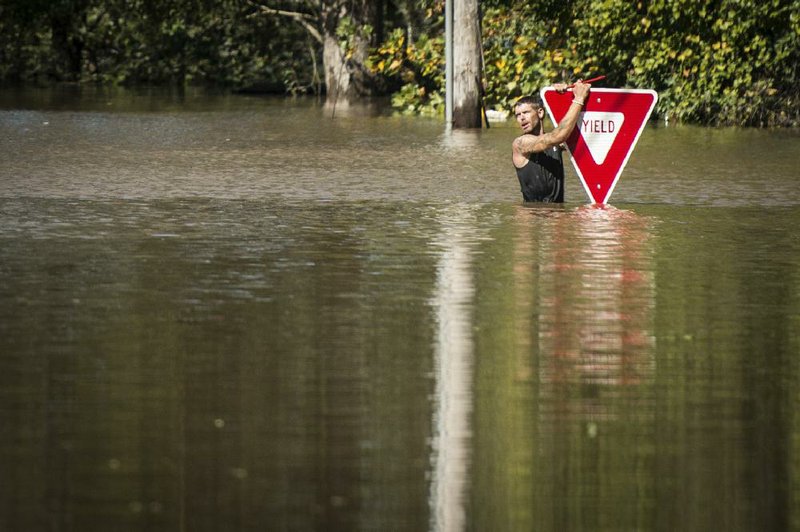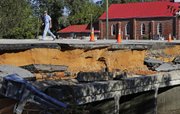FAYETTEVILLE, N.C. — Hurricane Matthew dumped torrential rains on North Carolina before its remnants rammed the Virginia coastline early Sunday, causing widespread flooding and knocking out power to hundreds of thousands.
In North Carolina, Coast Guard rescuers reached thousands of people with helicopters and military vehicles. One woman held on to a tree for three hours after her car was overrun by floodwaters.
Much of the southeastern coast was spared the catastrophic damage that was once feared, but the hurricane wreaked havoc 100 miles or more inland. The storm killed more than 500 people in Haiti and at least 18 in the U.S. — eight of them in North Carolina. Florida reported four storm deaths, and Georgia and South Carolina reported three each. Most were swept away by floodwaters, though some were killed by falling trees or by carbon monoxide fumes from a generator. One 66-year-old man near Columbia, S.C., died at a nursing facility when he got pinned under his electric wheelchair in water.
Gov. Pat McCrory said authorities were searching for five people and feared they may find more victims. The problems were far from over as more than a foot of rain flows into rivers and downstream, likely causing major flooding in many of the same places devastated by a similar deluge from Hurricane Floyd in 1999.
[ MATTHEW’S IMPACT: Map of power outages, shelters]
[HURRICANE TRACKER: Follow Hurricane Matthew’s path so far]
“Hurricane Matthew is off the map. But it is still with us. And it is still deadly,” McCrory said.
Princeville, a town of 2,000 that disappeared in the waters of the Tar River during Floyd, was evacuated Sunday as the river was expected to rise to 17 feet above flood stage later today — a level not seen since Floyd. McCrory expected more evacuations as some rivers were predicted to crest Friday.
David Bullock, a resident of Princeville, said he was out buying lottery tickets when his sister called to tell him police were knocking on doors saying they had to go. He rebuilt his home after the 1999 flood.
“If I get flooded again, I can’t take it,” Bullock said. “I can’t go back and take the expense. If I get flooded again, I’m going to say, ‘It’s yours, I’m gone.’”
More than a million people in South Carolina and North Carolina were without power, and at least four separate sections of Interstate 95 — the main artery linking the East Coast from Florida to Maine — were closed in North Carolina.
[WATCH: Video shows plane flying into eye of Hurricane Matthew]
The ferocity of the rain caught people by surprise. Ezekiel Crowe, 10, escaped the floods in Fayetteville, N.C., on Saturday with his parents and seven brothers and sisters when a police boat plucked them from an apartment.
“I was scared. I was scared. And I thought, I thought the world was going to end. But it didn’t,” he said.
In Wilson County, rescuers were called when a 63-year-old woman didn’t make it home from work. They heard her cries for help while riding on top of a Humvee, and when they couldn’t get her with a rope, a National Guard soldier swam to her, staying until a rescue boat arrived, Emergency Management Director Gordon Deno said.
Even animals had to be saved. WRAL-TV showed a dog swimming around floodwaters Saturday. McCrory said he and his wife were riveted by the coverage and relieved to find out from the Coast Guard that it rescued the dog, which had managed to get into a tree.
The rainfall totals were staggering: Nearly 15 inches in Fayetteville and 8 inches in Raleigh. McCrory warned that cities along rivers in eastern North Carolina needed to be prepared for days of flooding. The Lumber River in Lumberton was 4 feet above its record level Sunday afternoon and was forecast to remain there for at least five days.
The hurricane was downgraded to a post-tropical cyclone Sunday and was moving out to sea. It still had hurricane-force winds of 75 mph.
VIRGINIA DECLARES
EMERGENCY
To the north, Virginia Beach and Norfolk, Va., declared states of emergency, and the National Guard was called in to assist with the cleanup and response effort. The storm dumped as much as 10 inches of rain on parts of southeastern Virginia, with locally higher amounts, according to weather officials.
“We’re seeing a little bit of everything — it’s downed trees, downed limbs, power lines, some debris blown around, certainly a lot of flooding,” Julie Hill, a spokesman for the city of Virginia Beach said Sunday. “Some of the streets are impassable so we can’t even get to the other sides to assess damage.”
No storm-related deaths were reported in the state, but rescue efforts took place throughout the night Sunday. Nearly 200,000 were without electricity in the corridor from Virginia Beach to Richmond by late-morning Sunday, according to Dominion Virginia Power. Another 50,000 had lost power elsewhere in the state.
National Weather Service Meteorologist Mike Dutter said steady rainfall began Saturday afternoon and continued well into Sunday morning, dumping anywhere from 6 to 10 inches in most of southeastern Virginia, with local amounts up to a foot. The storm brought sustained winds of 30 to 50 mph, with gusts up to 65 mph.
The higher-than-expected moisture came after the hurricane clashed with a cold front that had originated in the Ohio valley.
“The timing of it was just ideal in that sense that the hurricane was moving up off [the Outer Banks] at the same time the front was moving in, and it just caused the dramatic rainfall,” Dutter said.
After a downed tree blocked road access in his neighborhood, Virginia Transportation Secretary Aubrey Layne held a news conference in Little Neck, where he lives, the Virginian-Pilot reported.
“The effects of the storm were more severe than we anticipated,” Layne said, according to the paper, saying standing water, severe winds and downed trees were the biggest issues facing the state.
Floodwaters ranged from knee-deep to neck-high, Layne said.
“I don’t think anybody expected it to continue coming up this far north or to stall out,” she said. “There are some areas that are absolutely underwater and a lot of other roads blocked because of trees down.”
Elsewhere along the Atlantic coast, Savannah, Ga., was still without electricity after getting 17 inches of rain.
About 150 people stood in line Sunday waiting for a grocery store to open. Debbie Berta said she waited more than an hour to get propane gas for her grill. She also wanted “bread, potatoes, eggs — and a piece of sanity.”
An estimated 2 million people in the Southeast were ordered to evacuate their homes last week as Matthew closed in. President Barack Obama had declared a state of emergency from Florida to the Carolinas.
“People were hit. They weren’t hit as directly as we had feared, but it has left a lot of devastation in its wake,” Obama said Sunday at a fundraiser in Chicago. “Lives have been lost, property has been severely damaged and there’s still continuing risk of flooding going on.”
Information for this article was contributed by Martha Waggoner, Allen Breed, Jonathan Drew, Jeffrey Collins, Jack Jones, Russ Bynum and Terrance Harris of The Associated Press; and by Faiz Siddiqui of The Washington Post.


